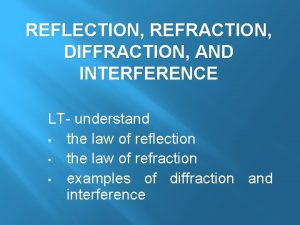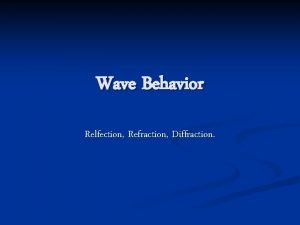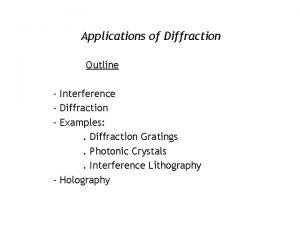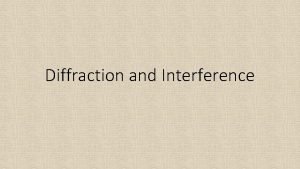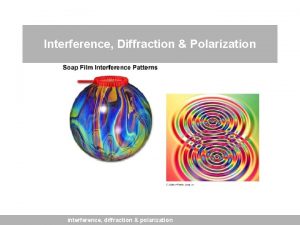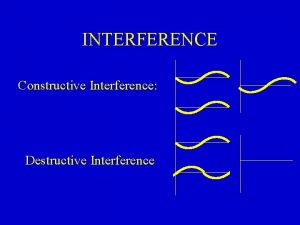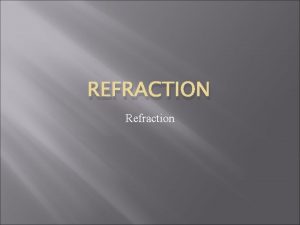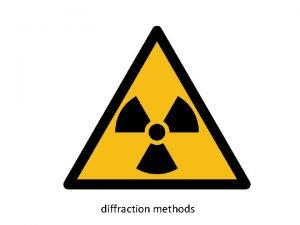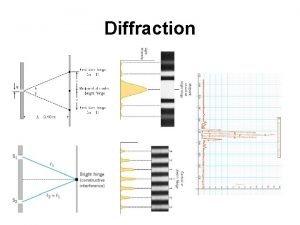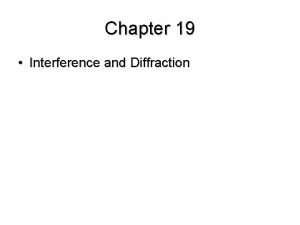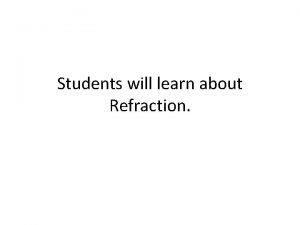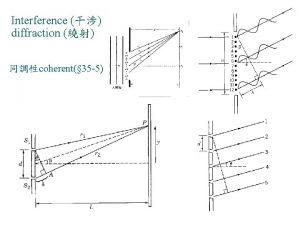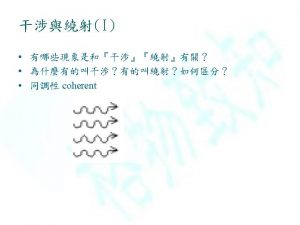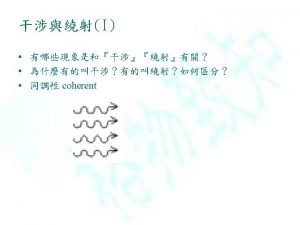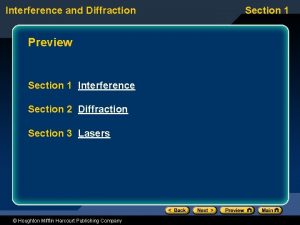4 Refraction 4 Interference Diffraction Refraction Learning Intentions
























- Slides: 24

4. Refraction 4. Interference, Diffraction & Refraction

Learning Intentions �Investigate the relationship between the angle of incidence and the angle of refraction. �Investigate the refractive index of different materials. Success Criteria: By the end of the lesson I should be able to… �state what is meant by the term “refractive index” �state and use the relationship between angle of incidence, angle of refraction and refractive index.

Refraction What do you remember about refraction from N 5? On a whiteboard copy and complete the following diagram of light passing from air to glass and out again- indicating the angles of incidence and refraction and the normal.

Refraction �When light enters a material that is more dense its speed decreases and the angle between the ray of light and the normal decreases. �When light enters a material that is less dense its speed increases and the angle between the ray of light and the normal increases.

Refractive Index Do you know what this means? If not, look it up

Refractive Index The refractive index of a material is a measure of the extent to which light can be refracted relative to air. It is also, by extension a measure of the extent to which the speed of light is affected during refraction. The refractive index of air is n=1 All other refractive indexes are measure relative to this.

Refractive Index �The refractive index of a material is a measure of the refraction of light in the material relative to air. �It is given the symbol n. �As it is a relative measurement it has no units.

Snell’s Law

Example 1 Calculate the refractive index of water

Example 2 The following results were obtained when a ray of monochromatic light was sent from air into a perspex block.

SCHOLAR Simulation & Questions

Problems Page 28 Questions 1 & 2

Snell’s Law Extension Since the speed of light changes when it is refracted we can also say:

Example A ray of white light passes from air into glass as shown The refractive index of the glass is 1. 65 for red light and 1. 68 for blue light. The speed of the light in air is 3. 00 x 108 m s-1. 1. Calculate the speed of the red light in the glass. 2. Taking the wavelength of the red light in air as 700 nm, calculate the wavelength of the red light in the glass.

Refraction & Frequency What determines the frequency of a wave? The frequency of a wave is determined by the source that generated the wave. As a consequence of this, no matter what happens to a wave after it has been generated, its frequency does not change. This means that, when a light wave passes from one medium into another (when it is refracted) its frequency is unaltered.

Refraction & Frequency The refractive index of a medium depends on the frequency of the incident light. Since wavelength and colour of light also depend on frequency, it follows that light of different wavelengths and therefore different colours will be refracted by different amounts.

Example A ray of white light passes from air into glass as shown below The refractive index of the glass is 1. 65 for red light and 1. 68 for blue light. Calculate the angle between the red light and the blue light in the glass (the angle of dispersion the process of splitting up light into its constituent colours ).

Refraction Summary Property Light moving into less dense material Light moving into more dense material Angle between ray and normal Increases Decreases Velocity Increases Decreases Wavelength Increases Decreases Frequency No effect

Questions Section 6. Refraction of Light Q 3 -7

Refractive Index of Perspex �Aim: to calculate the refractive index of the Perspex block. �NB: You will only be able to perform this experiment for angles less than approx. 45 o due to internal reflection.

Refractive Index of Perspex �What are our variables? �What equipment will we need? �Are there any safety precautions we will need to take?

Results Table Angle in Air (θ₂) ° Angle in Perspex (θ₁) ° 1 0 5 10 15 20 25 30 35 40 2 3 4 5 Sin θ₂ Av Sin θ₁


Uncertainty in refractive index n n= %∆n=
 Reflection refraction diffraction interference
Reflection refraction diffraction interference Interference diffraction and polarization
Interference diffraction and polarization Reflection refraction diffraction
Reflection refraction diffraction Reflection refraction diffraction
Reflection refraction diffraction Proactive vs retroactive interference
Proactive vs retroactive interference Source amnesia
Source amnesia Jabberwocky alliteration
Jabberwocky alliteration Learning intentions examples
Learning intentions examples Learning intention examples
Learning intention examples Learning intentions and success criteria examples
Learning intentions and success criteria examples Nat 5 persuasive essay
Nat 5 persuasive essay Place value learning intentions
Place value learning intentions Annotate poem generator
Annotate poem generator Fractions learning objectives
Fractions learning objectives Half turn symmetry
Half turn symmetry Learning intentions verbs
Learning intentions verbs Poetry learning intentions
Poetry learning intentions Learning intentions and success criteria for mathematics
Learning intentions and success criteria for mathematics Poetry learning intentions
Poetry learning intentions 8 mark question
8 mark question Reflective phrases
Reflective phrases Acrostic poem g
Acrostic poem g The crucible character map
The crucible character map The meaning of advent worksheet
The meaning of advent worksheet Shared clarity about learning intentions
Shared clarity about learning intentions
